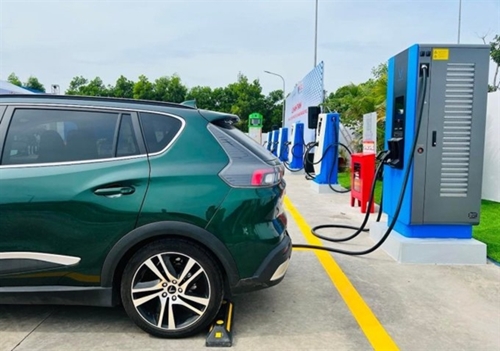The main drivers for the interest are reduced operating costs, climate change concerns, and personal health benefits. Driving experience is also an important factor.
According to the study, about 49% of Vietnamese people still favor petrol and diesel, an increase of around one% compared to last year.
    |
 |
|
A VinFast EV at a charging station in Hanoi (Photo courtesy of VinFast) |
Meanwhile, the number of users interested in battery electric vehicles (BEV) and plug-in hybrid electric vehicles (PHEV) accounts for 16% and 17%, respectively.
Regarding hybrid vehicles (HEV), only about 9% of Vietnamese are interested in this vehicle line, two or three times lower than other countries in the region such as Thailand, Singapore, the Philippines, Malaysia or Indonesia.
The majority (48%) of EV owners in Việt Nam still rely primarily on charging at home. However, a significant proportion (20%) now regularly charge at their workplace, which is the highest rate among the surveyed countries. Around a third (32%) of current Vietnamese EV owners use public charging stations or on-street charging.
Southeast Asian countries are now prioritizing a roll out of public charging stations, driven by concerns about 'range anxiety' - the fear of running out of battery power.
If EV owners cannot charge at home, they need reassurance that a public charge point is conveniently close by.
The study stressed that this issue requires strategic vision to maximize profits from investing in building a national public charging system.
The data on electric vehicle (EV) charging times shows how long drivers would be willing to wait at public charging stations to charge their vehicle from empty to 80%.
Approximately 37% of EV users are willing to wait between 21 and 40 minutes, 31% of users expect the charging process to take between 10-20 minutes and only 10% of users are willing to accept waiting up to 10 minutes.
According to Deloitte, the suggestion that charging an electric vehicle takes the same amount of time as filling a fossil fuel tank is exaggerated. In reality, consumers in most Southeast Asian markets are willing to wait more than 10 minutes to charge their vehicles.
The report concludes that, when it comes to pure electric vehicles (EVs), consumers in Southeast Asia are mainly concerned about insufficient charging station infrastructure, charging times and vehicles suddenly running out of charge, along with costs.
In the Vietnamese market, the three biggest issues that users are concerned about regarding EVs are travel distance, battery charging time and knowledge about electric vehicles.
Only about four% of Vietnamese consumers are concerned about the limitations of brands and models available in the domestic electric vehicle market. This indicates that while there may be fewer choices compared to more established markets, it is not a primary concern for most consumers.
Source: VNA